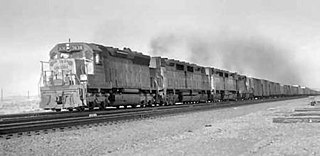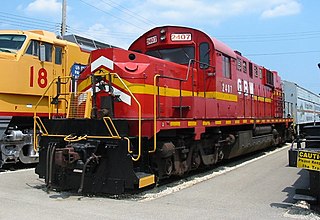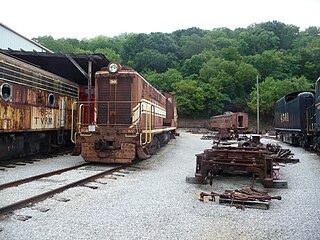Related Research Articles

A locomotive or engine is a rail transport vehicle that provides the motive power for a train. If a locomotive is capable of carrying a payload, it is usually rather referred to as a multiple unit, motor coach, railcar or power car; the use of these self-propelled vehicles is increasingly common for passenger trains, but rare for freight.

A diesel locomotive is a type of railway locomotive in which the prime mover is a diesel engine. Several types of diesel locomotives have been developed, differing mainly in the means by which mechanical power is conveyed to the driving wheels.
The AAR wheel arrangement system is a method of classifying locomotive wheel arrangements that was developed by the Association of American Railroads. It is essentially a simplification of the European UIC classification, and it is widely used in North America to describe diesel and electric locomotives. It is not used for steam locomotives which use the Whyte notation instead.
Early Electro-Motive Corporation switchers were built with Winton 201-A engines. A total of 175 were built between February 1935 and January 1939. Two main series of locomotives were built, distinguished by engine size and output: the straight-8, 600 hp (450 kW) 'S' series, and the V12, 900 hp (670 kW) 'N' series. Both were offered with either one-piece cast underframes from General Steel Castings of Granite City, Illinois, denoted by 'C' after the power identifier, and fabricated, welded underframes built by EMC themselves, denoted by 'W'. This gave four model series: SC, SW, NC and NW. Further developments of the 900 hp (670 kW) models gave model numbers NC1, NC2, NW1, and NW1A, all of which were practically indistinguishable externally from the others, as well as a pair of unique NW4 models for the Missouri Pacific Railroad and a solitary, twin-engined T transfer locomotive model built for the Illinois Central Railroad.

The EMD DD35 was a 5,000 horsepower (3,700 kW) road switcher diesel-electric locomotive of D-D wheel arrangement built by General Motors Electro-Motive Division for the Union Pacific Railroad and Southern Pacific Railroad.

The Consolidated line, or C-line, was a series of diesel-electric railway locomotive designs produced by Fairbanks-Morse and its Canadian licensee, the Canadian Locomotive Company. Individual locomotives in this series were commonly referred to as “C-liners”. A combined total of 165 units were produced by F-M and the CLC between 1950 and 1955.
Railpower Technologies Corp. is a subsidiary of R.J. Corman Railroad Group that builds environmentally friendly hybrid Green Goat and Genset switching locomotives, founded by Frank Donnelly and Gerard Koldyk. Its locomotives have been purchased by Canadian Pacific Railway, BNSF Railway, Kansas City Southern Railway and Union Pacific Railroad among others.

The Indian Railways primarily operates fleet of electric and diesel locomotives, along with several compressed natural gas (CNG) locomotives. Steam locomotives are operated on a few World Heritage sites and also run occasionally as heritage trains. A locomotive is also known as a loco or more popularly as an engine. The country's first steam locomotive ran on the Red Hill Railway from Red Hills to the Chintadripet bridge in Madras in 1837.

The Alco RSD-15 is a diesel-electric locomotive of the road switcher type built by the American Locomotive Company of Schenectady, New York between August 1956 and June 1960, during which time 75 locomotives were produced. The RSD-15 was powered by an Alco 251 16-cylinder four-cycle V-type prime mover rated at 2,400 horsepower (1.79 MW); it superseded the almost identical Alco 244-engined RSD-7, and was catalogued alongside the similar but smaller 1,800 hp (1.34 MW) RSD-12, powered by a 12-cylinder 251-model V-type diesel engine.

The Baldwin VO-1000 is a diesel-electric locomotive (switcher) built by Baldwin Locomotive Works between January 1939 and December 1946. The 236,260–242,200 lb (107,170–109,860 kg) units were powered by a normally aspirated eight-cylinder diesel engine rated at 1,000 horsepower (746 kW), and rode on a pair of two-axle trucks in a B-B wheel arrangement. These were either the AAR Type-A switcher trucks, or the Batz truck originally developed by the Atchison, Topeka and Santa Fe Railway as a leading truck for steam locomotives. 548 examples of this model were built for American railroads, including examples for the Army and Navy.

The Century 424 was a four-axle, 2,400 hp (1,790 kW) diesel-electric locomotive of the road switcher type. 190 were built between April 1963 and May 1967. Cataloged as a part of Alco's Century line of locomotives, the C424 was intended to replace the earlier RS-27 model and offered as a lower-priced alternative to the C425. Montreal Locomotive Works also built this locomotive as MLW Century 424.
The Erie-built was the first streamlined, cab-equipped dual service diesel locomotive built by Fairbanks-Morse, introduced as direct competition to such models as the ALCO PA and FA and EMD FT. F-M lacked the space and staff to design and manufacture large road locomotives in their own plant at Beloit, Wisconsin, and was concerned that waiting to develop the necessary infrastructure would cause them to miss out on the market opportunity for large road locomotives. Engineering and assembly work was subcontracted out to General Electric, which produced the locomotives at its Erie, Pennsylvania, facility, thereby giving rise to the name "Erie-built."

The EMD GP16 are a series of rebuilt road switcher diesel-electric locomotives, a result of a remanufacturing program initiated by the Seaboard Coast Line Railroad (SCL) in an effort to spare the cost of purchasing new motive power in the late 1970s. This involved the rebuilding of their aging fleet of EMD GP7, GP9, and GP18 road switchers. 155 locomotives were rebuilt by the SCL.

The New Zealand DSC class locomotive is a heavy shunting locomotive used throughout New Zealand. The class was built in seven batches, the first 18 locomotives being built by British Thomson-Houston of the United Kingdom, with the remainder being built by New Zealand Railways (NZR).

The EMD GP22ECO is a 2,150 hp (1,600 kW) B-B road switcher diesel-electric locomotive rebuilt by Electro-Motive Diesel and Norfolk Southern's Juniata Shops. Initially EMD built two GP22ECO demonstrators, one based on a GP9 and one based on a GP40, but thus far all orders have been for conversions based on EMD GP40 and EMD GP40-2 series locomotives. The rebuild involves replacing the existing prime mover with an EPA Tier-II-compliant turbocharged V8 710G3A, with Electronic fuel injection. The prime mover is mated to an AR10 alternator for traction power, a CA6 alternator for control power, and a computerized control system. Applying this to a 6-axle locomotive results in a SD22ECO. Some 6-axle locomotives could alternately be converted into a SD32ECO, using a 3,150 hp (2,350 kW) V12 instead.

Baldwin, the locomotive manufacturer, and Westinghouse, the promoter of AC electrification, joined forces in 1895 to develop AC railway electrification. Soon after the turn of the century, they marketed a single-phase high-voltage system to railroads. From 1904 to 1905 they supplied locomotives carrying a joint builder's plate to a number of American railroads, particularly for the New Haven line from New York to New Haven, and other New Haven lines.
The KLW SE10B is a low-emissions diesel switcher locomotive built by Knoxville Locomotive Works. It is powered by a single MTU Series 2000 engine which develops a total power output of 1,050 horsepower (783 kW). There have been three SE10B locomotives produced for New York New Jersey Rail, and an unknown number is being produced for Chevron to be used in the refineries of Houston and Beaumont-Port Arthur, Texas.

The KLW SE15B is a low-emissions diesel switcher locomotive built by Knoxville Locomotive Works. It is powered by a single MTU Series 2000 engine which develops a total power output of 1,560 horsepower (1,160 kW). An unknown number SE15B locomotives is being produced for Chevron to be used in the refineries of Houston and Beaumont-Port Arthur, TX.
The KLW SE24B or KLW SE20B is a low-emissions diesel switcher locomotive built by Knoxville Locomotive Works. It is powered by a single MTU Series 4000 12V R54 diesel engine which develops a total power output of 2,400 horsepower (1,790 kW). To date, one SE20B locomotive has been produced for KLWX, and it is performing performance disassembly and operating on the Gulf & Ohio Railways.
The KLW SE32C is a low-emissions diesel road locomotive built by Knoxville Locomotive Works. It is powered by a single MTU Series 4000 16V R54 diesel engine which develops a total power output of 3,200 horsepower (2,390 kW). To date, 2 SE32C locomotives have been produced.
References
- ↑ "Knoxville Locomotive Works". Knoxville Locomotive Works. Retrieved 2019-03-28.
- ↑ Knoxville Locomotive Works
- ↑ "KLW SE15B & SE10B: Switchers for the 21st Century". 2016. Retrieved 20 December 2016.
- ↑ "For New York New Jersey Rail, new KLW power". 13 August 2015. Retrieved 20 December 2016.
- ↑ "From KLW, a new breed of repowers". 19 December 2016. Retrieved 20 December 2016.
- ↑ "KLW SE15B & SE10B: Switchers for the 21st Century". 2016. Retrieved 20 December 2016.
- ↑ "From KLW, a new breed of repowers". 19 December 2016. Retrieved 20 December 2016.
- ↑ "KLW SE24B: For Yard and Road Switching". 2016. Retrieved 20 December 2016.
- ↑ "KLW SE32C: For More Demanding Operations". 2016. Retrieved 20 December 2016.